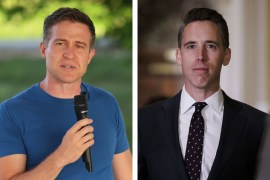President Joe Biden has promised enough covid vaccine to immunize every willing adult by June 1. But right now, the gap between supply and demand is so dramatic that vaccinators are discovering ways to suck the final drops out of each vaccine vial — if federal regulators will let them.
Pharmacists involved in the covid vaccination drive say it’s common to have half a dose left in a Pfizer vial after five or even six doses have been administered — and to have half a dose left after 10 doses have been drawn out of a Moderna vial. Combining two half-doses could increase vaccinations by thousands at a time when 2 million or so doses are being administered every day in the country.
So, they want to use a single hypodermic needle to withdraw leftover vaccine from two vials from which all full doses already have been removed. The American Society of Health-System Pharmacists asked the Food and Drug Administration to consider granting permission to do so in a recent letter. The governors of Colorado and Oregon also have sought permission to allow their pharmacists to pool covid vaccine vials.
Federal health regulators, however, have long opposed the reuse of drug vials because of the risk of introducing a bacterial contaminant. From 1998 to 2014 more than 50 outbreaks of viral or bacterial disease were reported as a result of unsafe injection practices, including injecting multiple patients with a drug from the same vial.
The FDA wouldn’t comment on the pharmacists’ letter but restated to KHN its current policy that “doses not be pooled from different vaccine vials, especially for coronavirus vaccines, which are not formulated with a preservative.” On its website, the Centers for Disease Control and Prevention explicitly tells vaccinators to discard vials “when there is not enough vaccine to obtain a complete dose. Do NOT combine residual vaccine from multiple vials to obtain a dose.”
“It’s a recipe for disaster,” said Ann Marie Pettis, president of the Association for Professionals in Infection Control and Epidemiology. There is always a tiny chance that one of the two vials has previously been contaminated, which would contaminate a shot that combined their contents, she said. Spokespeople for both Moderna and Pfizer said excess portions of their vaccines must be discarded and never pooled. Johnson & Johnson had no comment on the issue.
Before the covid vaccination program, public health officials generally frowned on giving multiple patients doses of medicine from a single vial, unless it contained an antibacterial preservative. Most children’s vaccines, for example, have been shipped and stored in syringes or single-dose vials since 2001, when drug companies stopped using a preservative containing traces of mercury in some shots.
Rajesh Gupta, a biologics consultant who set up a sterility testing lab while serving at the FDA’s Center for Biologics Evaluation and Research from 2006 to 2013, sees little risk in the covid vaccination process, or even in using a single needle to combine vaccine from two vials.
The covid vaccines are being used so quickly after removal from cold storage that there’s no danger of contamination, he said. “I can say with some degree of confidence that it’s scientifically sound,” if vaccinators carefully wipe the rubber stopper atop the vial with disinfectant before each penetration with a syringe, he said.
While their plea for combining vial contents may fall on deaf ears at the FDA, pharmacists already are taking many other steps to maximize the yield of the mRNA vaccines, which have quite finicky shipment, handling and administration requirements.
Documents leaked through a cyberattack on the European drug regulatory agency suggest that Pfizer has had difficulty assuring the quality of the mRNA in its vaccine. The company said in response that all the vaccine doses it has put on the market had been “double tested to ensure compliance” with regulatory specifications.
Michael Hogue, president of the American Pharmacists Association and dean of the Loma Linda University School of Pharmacy in California, runs a clinic at a university gymnasium that has been administering up to 10,000 vaccines each week since Jan. 28. It’s nowhere near as simple as administering flu shots at a pharmacy, he said.
“The planning and procedures for these mRNA vaccines [made by Pfizer-BioNTech and Moderna] require a tremendous amount of focus,” said Hogue. “You have to pay close attention to what’s going on in the moment.”
The Pfizer vaccine, which until recently was always stored in dry ice, is especially challenging. After Pfizer vials are removed from a freezer and thawed, saline solution is squirted into each vial. If the syringe preparer doesn’t withdraw air from the vial after adding the saline, vaccine will shoot out.
After adding the solution, “you take the vial between thumb and forefinger and make a rainbow sweeping motion 10 times gently to mix the liquids together,” Hogue said. Shaking the vaccine could render it ineffective.
Each Pfizer vaccination contains just a bead of liquid — about 1/16th of a teaspoon — and pharmacists must use tiny syringes in which air bubbles tend to form. But they can’t tap on the syringe to get the bubble out, because that, too, could damage the vaccine, Hogue said.
To get six doses out of the Pfizer vials requires a type of plunger that pushes the last trace of vaccine out of the syringe. But about 15% of the syringes the federal government has been shipping to Loma Linda have larger needles that leave a bit of vaccine in the syringe, making it impossible to extract all six doses, he said. So, Loma Linda has been purchasing its own syringes to replace the inadequate ones.
U.S. Pharmacopeia, a nonprofit agency that issues standards for use of medical products, issued an 11-page guide on how to store, handle and administer the covid vaccines. Among other things, it urges that vaccine sites set up clean rooms — separate from the areas where vaccines are being administered — to prepare the syringes, said Farah Towfic, director of CEO operations for USP.
“That way we don’t have clients breathing on it,” not to mention the distraction of greeting old acquaintances who are bubbling over with enthusiasm about getting vaccinated, said Patricia Slattum, a retired Virginia Commonwealth University pharmacy school professor who has been volunteering at a mass vaccination site in Richmond, Virginia. “There’s a lot of love to go around in there.”
Another technique is to inject each needle into a different spot on the rubber vial stopper. If the syringe goes into the same location over and over, it can create a big hole that causes leakage. This tip is especially important now that Moderna is in talks with the FDA to include up to 15 doses of vaccine in each vial, meaning 15 punctures of the stopper, noted Anna Legreid Dopp, director of clinical guidelines and quality improvement at the American Society of Health-System Pharmacists.
“To draw up the vaccine, you stick a needle through the rubber stopper, then turn the vial upside down,” said Slattum. “If you stick it in the same place, drops will leak down the needle. So there’s an art to not losing vaccine.”
Slattum hopes the FDA will consider allowing vaccinators to draw the leftover vaccine from two vials. “We who are doing this work all feel this pressure, that our doing it well is one of the ways we’re going to get out of this pandemic,” said Slattum. “You just don’t want to waste any vaccine!”
This story was produced by KHN, which publishes California Healthline, an editorially independent service of the California Health Care Foundation.
Update: Farah Towfic’s job title at USP was incorrect in an earlier version.







